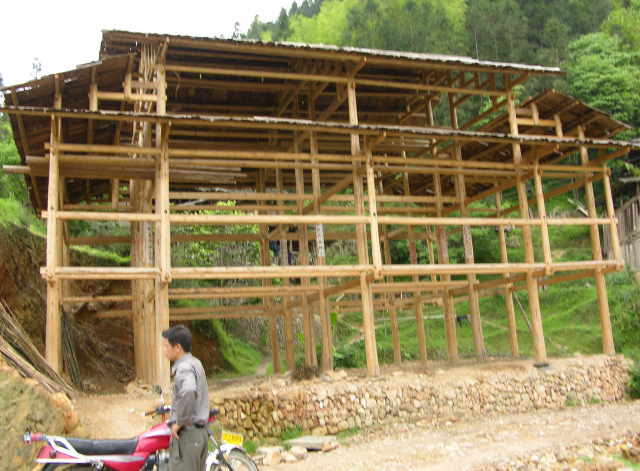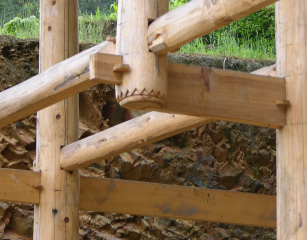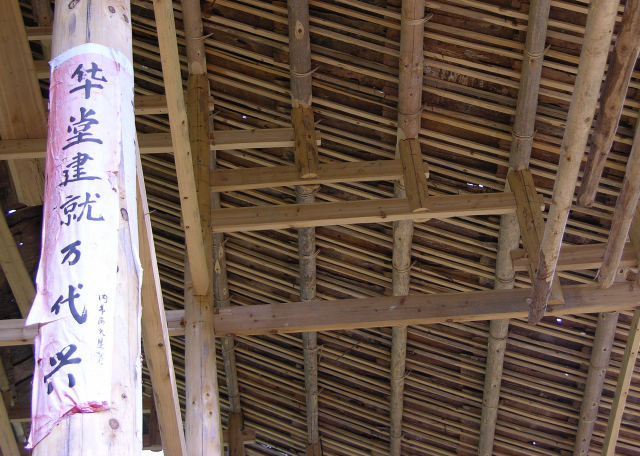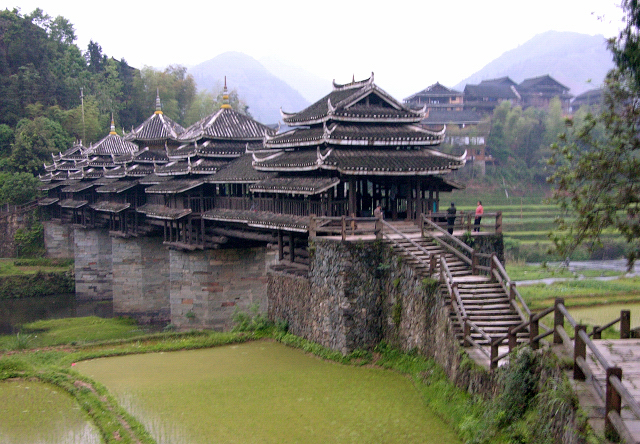Chinese Architecture and House Construction
The housing styles,
construction and building
techniques of China's minorities vary from region to region depending on climate, availability of
materials, and geography of the land.
 Typically, most minorities use
a Chinese variation of post and beam technique with mortise and tendon
joinery. Having always been one who could not pass up a construction
site, I took the opportunity to ask questions and take pictures of this house under
construction in a Zhung ethnic minority village outside Sanjian.
The structure is at least 45 feet wide. The scale is visually thrown
off because, though he looks much closer, the man is the photo is actually
about 20 feet from the front of the structure.
Typically, most minorities use
a Chinese variation of post and beam technique with mortise and tendon
joinery. Having always been one who could not pass up a construction
site, I took the opportunity to ask questions and take pictures of this house under
construction in a Zhung ethnic minority village outside Sanjian.
The structure is at least 45 feet wide. The scale is visually thrown
off because, though he looks much closer, the man is the photo is actually
about 20 feet from the front of the structure.
The massive timbers may be cut
from a considerable distance away and are transported by the local
villagers.
The ridgepole is considered to
be very important and has much spiritual significance. It is
carefully chosen by the spiritual leader who may take a week or more to find the
"correct" tree. This tree can NEVER be allowed to touch
the ground or it will lose its power. Keep in mind that this tree may (and
probably was) growing high up on a steep mountainside, and there are no heavy
equipment or power tools being used. The entire village is involved
in felling, supporting, and transporting this tree. It is a very
dangerous process.
It takes a week for a village
to raise the posts and beams into place. After that, it is the home owners
responsibility to finish the construction. He may do the work himself or
hire others to work for him.

The posts are
placed on a flat stone which is buried to be almost level with the
ground. I asked if they had "tiny insects which live in
the ground and eat wood"---termites. Yes, they are alive and
very well fed under the minority villages. It is a serious
problem for the villages. I was asked what we did about them where I
came from....and I did feel a bit uncomfortable explaining that put chemicals
into the ground which poisons the insects. Some minorities believe
that spiders are past relatives who come back to watch over their human
off-spring so the "poison" idea was received with looks of horror and
disbelief.

This picture is of the support
structure for the roof. After the support beams are place,
bamboo strips are nailed on top of them and these are covered with large wood
shingles which are then covered with roof tiles. No, the writing on
the red paper is not a building permit....it is prayer to the ancestors.
Chinese Dong Minority Awesome Architecture
Wind and Rain bridge
is one of the required elements that marks the entrance to the Dong minority
village.
 Notes from Jessy
Notes from Jessy
Cheng Yang Wind & Rain
Bridge, is located in Cheng Yang village, where belongs to San Jiang county.
It is the biggest wind & rain bridge in Sanjiang.
It was built in 1916, it took
the villagers over 10 years to build it. The
bridge is 64.4 meters long(70 yard), 3.4 meters wide(11 feet), 10.6 meters
high (35 feet).
The amazing part is, there is
no nail with the whole instruction.
coming soon
the Qing
dynasty nobles house in Tia Jiang which is now a museum.
Return
to Home Page
 Typically, most minorities use
a Chinese variation of post and beam technique with mortise and tendon
joinery. Having always been one who could not pass up a construction
site, I took the opportunity to ask questions and take pictures of this house under
construction in a Zhung ethnic minority village outside Sanjian.
The structure is at least 45 feet wide. The scale is visually thrown
off because, though he looks much closer, the man is the photo is actually
about 20 feet from the front of the structure.
Typically, most minorities use
a Chinese variation of post and beam technique with mortise and tendon
joinery. Having always been one who could not pass up a construction
site, I took the opportunity to ask questions and take pictures of this house under
construction in a Zhung ethnic minority village outside Sanjian.
The structure is at least 45 feet wide. The scale is visually thrown
off because, though he looks much closer, the man is the photo is actually
about 20 feet from the front of the structure.

 Notes from Jessy
Notes from Jessy